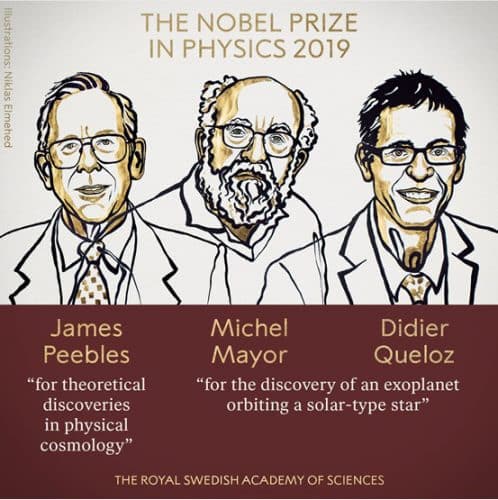The Nobel Prize in Physics for the year 2019 was awarded to three researchers: half of the prize was awarded to the researcher James Peebles for his theoretical discoveries in physical cosmology and especially on the cosmic background radiation, and the other half jointly to the two researchers Michel Maior and Didier Cavalloz for the discovery of a planet orbiting a star outside the solar system

The 2019 Nobel Prize in Physics was awarded to three researchers: half of the prize was awarded to the researcher James Peebles for his theoretical discoveries in physical cosmology and especially on the cosmic background radiation, and the other half jointly to the two researchers Michel Maior and Didier Cavaloz for the discovery of a planet orbiting a star outside the solar system.
The 2019 Nobel Prize in Physics is being awarded for new insights into the structure and history of the universe, and for the first-ever discovery of the holiday planet around a sun-like star outside our solar system. These discoveries forever changed our understanding of the world we live in.
Nobel laureate in physics for 2019 James Peebles took it upon himself to face the entire universe, for all the billions of galaxies and clusters of galaxies within it. The theoretical framework he developed over two decades forms the basis of his modern understanding of the history of the universe, starting with the Big Bang and ending with the present day.
2019 Nobel laureates in physics Michel Mayor and Didier Queloz explored our home galaxy, the Milky Way, with the goal of uncovering unknown worlds. In 1995 they revealed their first discovery of a star outside our solar system, an extrasolar star around a sun-like star, dubbed 51 Pegasi b.
The discovery of two of the 2019 Nobel Prize winners in physics, Michel Mayor and Didier Cavalloz, started a real revolution in the field of astronomy and since their first discovery, another 4000 extrasolar stars have been discovered in the Milky Way galaxy. Strange new worlds are still being uncovered from time to time today, worlds of a huge variety of sizes, shapes and orbits, most of which are nothing like our own, which includes the sun and the holiday planets around it. These discoveries led researchers to develop new theories regarding the physical processes responsible for the creation of stars.
Genesis of the Big Bang Cosmology (for more)
The last five decades constitute the golden age of the world of cosmology, the study of the creation and development of our universe. In the 1971s, the groundwork was laid that would shift the field of cosmology from mere speculation to solid science. The key researcher in this change was James Peebles, whose proven discoveries put the field of cosmology on the scientific map, while enriching the entire field of research. The first book he published, Physical Cosmology (XNUMX), inspired an entire generation of physicists who continued to contribute to the development of the field, not only through theoretical hypotheses but also based on observations and measurements. Science, and only it, will be able to give answers to the basic questions regarding the source of our origin and the place to which we are progressing; The field of cosmology has freed itself from human ideas such as faith and existential meaning. This development echoes the words of Albert Einstein from the beginning of the last century who stated that the mystery of the world is its complete understanding.
The story of the universe, a scientific narrative of the evolution of the world, has only become familiar during the last hundred years. Earlier, the universe was seen as a stationary and eternal structure, but in the XNUMXs astronomers discovered that all galaxies are moving away from each other and from our galaxy. The universe is expanding. We now know that the present universe is different from yesterday's and will be different from tomorrow's as well.
What the astronomers saw in the sky was already predicted by Albert Einstein in the framework of the theory of relativity back in 1916, the theory that today forms the basis of all large-scale calculations of the universe. When Einstein discovered that his theory leads to the conclusion that the universe is expanding, he added a proviso to his equations (the cosmic constant) which would balance the effects of gravity and without it the universe would become a stagnant universe. Over the next decade, once the expansion of the universe was clearly observed, this caveat was no longer required. Einstein referred to this caveat as the greatest conceptualization of his life. He had no idea that the cosmological constant would return to the forefront of the scientific field of cosmology in the XNUMXs, thanks in no small part to the research contributions of James Peebles.
Interviews especially for the science site:
- Prof. Zvi Maza Mauni Tel Aviv: The science of planets outside the solar system is flourishing thanks to the genius of Michel Mayor, and the device he built
- Prof. Yoel Rafaeli of Uni' Tel Aviv: "Nobel winner Jim Peebles led theoretical research in cosmology for decades"
Technological improvement in the field of spectroscopy made possible the wave of discoveries of planets outside the solar system"
The breaking dawn over a distant sky / Michael D. Lemonique
